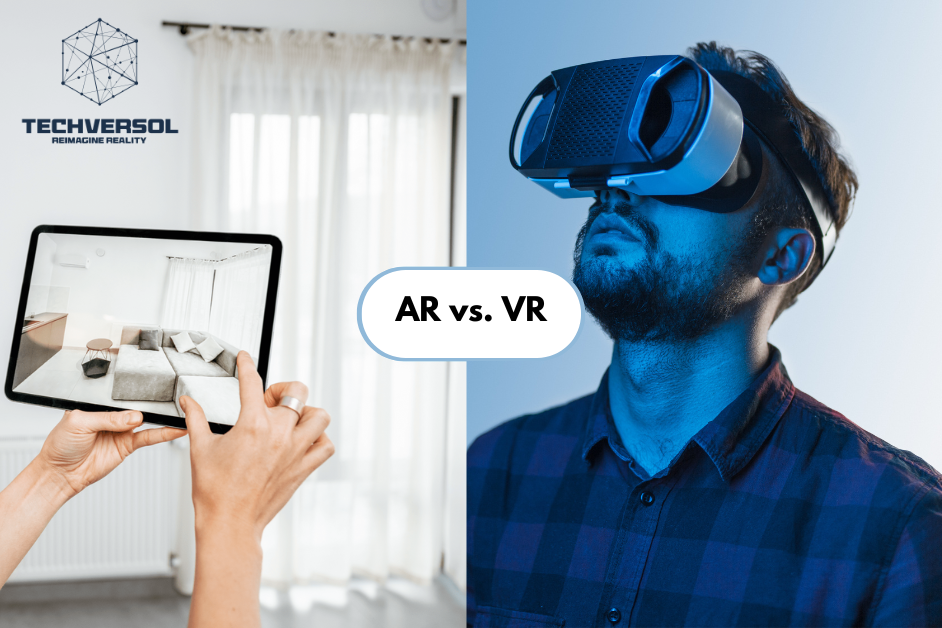Augmented Reality (AR) and Virtual Reality (VR) are different kinds of technologies that showcase mesmerizing experiences but vary fundamentally in their applications and approaches. Understanding these differences is crucial for learning how both technologies can be utilized and their possible impact.
AR and VR both technologies improve the way the users interact with digital information but both do these enhancements in different manners.
In this article, we are going to study the key differences between AR and VR which include their applications, user experiences, technologies, and definitions.
Concepts:
Augmented Reality (AR):
AR has a basis of overlaying digital information onto the physical world by improving your reality perception by adding digital content layers, including data, sounds, or images, on top of the view of the real-world environment. It commonly uses sensors, cameras, and displays to combine digital elements effectively with the physical world.
Virtual Reality (VR):
VR crafts a thoroughly immersive digital environment that effectively replicates the real physical world. AR users are thoroughly engaged in a virtual space where they interact with surroundings and objects of computer-generated. This technology requires a headset with screens and sensors to intercept the physical world and deliver a simulated experience.
Display:
AR:
AR can be thoroughly experienced through different types of devices such as tablets, smartphones, and specialized AR glasses (like Microsoft HoloLens or Google Glass). AR’s most typical form uses the screen and camera of a tablet or smartphone to effectively display digital information overlaid on the live video feed of the physical world.
VR:
This technology requires specialized primarily, hardware VR headsets such as the PlayStation VR, HTC Vive, and Oculus Rift. VR headsets have motion sensors and built-in screens to develop a thoroughly immersive experience. Mostly VR setups also include controller or external sensors to track movements to hand and improve interaction within the virtual environment.
Integration of Environment:
AR:
AR combines digital elements into the physical world for example, a smartphone app might use AR to display navigation directions overlaid on the traffic or non-traffic road as you drive or show virtual furniture in your bedroom when you’re preparing a home design.
VR:
This technology builds a distinct, completely digital environment for its specific users. The user is fully dipped in a computer-generated world and doesn’t catch the real-world surroundings. Their range can be from other planets’ virtual simulations to elaborate worlds of the video game.
Real and Virtual:
AR:
AR users can effectively interact with both elements of real and virtual simultaneously. For example, AR game players might witness characters of the digital world interacting with the real world that surrounds them. While engaging with augmented content, this combined interaction enables users to stay connected to their physical environment.
VR:
VR users are entirely immersed in a virtual environment with no interaction or are limited to the physical world. This entire immersion enables users to in-depth engagement with virtual content, meanwhile, users are separated physically from their primary surroundings.
Applications:
AR:
AR is usually used for interactive, practical purposes in professional settings and daily routines. This technology app can overlay points and directions of interest on a live camera feed. AR interactive tools and textbooks can improve learning and education by delivering dynamic visualizations of intricate concepts. It enables users to virtually see how their new furniture would look in their homes or try on dresses and clothes and it can deliver gradual instructions and learnings and visual support overlaid on equipment during repairs.
VR:
VR technology is commonly used for effective experiences that require total immersion. The games in VR deliver immersive worlds where users can interact with and explore virtual environments in such manners that traditional gaming cannot. This technology is utilized for field training which includes military, medicine, and aviation, where realistic simulations deliver hands-on experience without physical-world hazards.
Limitations and Benefits:
AR:
AR experience quality can be effectively affected by the camera and processing power of the device and the blending of physical and digital elements can occasionally be distracting or disorienting.
AR improves tasks in the real world by contributing interactivity and digital information and it enables users to integrate and multitask with real environments. This technology typically requires less specialized hardware, which makes it more convenient.
VR:
VR technology offers a thoroughly immersive experience that can be utilized for training, education, and entertainment and it enables customers of VR to interact with and explore scenarios and environments that are otherwise inapproachable or unusable.
VR demands technical hardware that can be costly or may require a dedicated space. VR’s immersive nature can lead to disconnection from the physical world and probable matters with spatial awareness.
Conclusion:
AR and VR are distinct but transformative effective technologies that provide exceptional ways to interact with experiences and digital information. It improves the physical world by overlaying digital elements onto real environments, which makes it convenient for everyday use and practical applications. VR makes a completely immersive virtual world, in contrast, perfect for in-depth engagement in training, simulation, and gaming.
It is crucial for every user and gamer to understand the contrasts between Augmented Reality (AR) and Virtual Reality (VR) assists in choosing the appropriate technology for precise conditions and applications. These technologies’ potential for impact and innovation, as both technologies continue to evolve, in different industries is extended, encouraging stimulating developments for the future.



